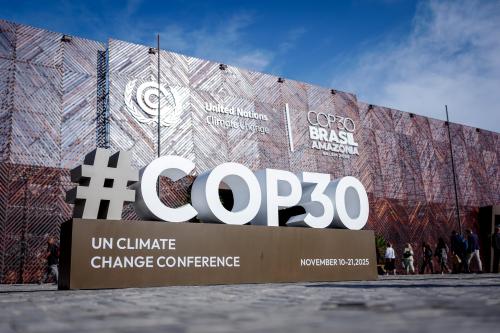The high-level round of this year’s climate talks have just ended in Doha, Qatar. These U.N.-based international negotiations have become increasingly complex, with different sets of countries involved in multiple agreements (see previous post Doha Climate Conference: Key Issues Up for Negotiation), and multiple negotiating tracks open at any given time. Accordingly, it is important to situate the outcomes in a broader perspective of: (a) setting and monitoring progress toward ambitious climate, development and economic growth goals for the international community; (b) enhancing the ability of existing institutions to make progress toward achievable outcomes; and (c) generating new approaches to reaching the goals we have set.
Seen in this context, the results of the recent Doha round are mixed. On the one hand, useful but minor progress was made in some of the more mundane operational parts of the regime – addressing part (b) above. Negotiators were able to wrap up a few outstanding negotiating tracks, agreeing on the details of a new commitment period for the Kyoto Protocol, and gathering new if somewhat miserly pledges of support for the new Green Climate Fund. On the other hand, there was not substantial progress on (a) or (c): negotiators failed to set a more ambitious series of international goals, nor did they move meaningfully toward a new international agreement which must be negotiated by 2015.
The conference in Doha was the 18th Conference of Parties to the United Nations Framework Convention on Climate Change (COP-18), and it ended in high drama on Saturday evening – a full 24 hours after the official closing of the conference, meant for Friday the 7th of December. What was widely thought to be a low-key, largely procedural meeting with a few key issues on the table for completion, instead dragged on for two weeks before erupting in disagreements and distrust in the final three days. Given the degree to which many Parties insisted on linking progress across tracks, it is not surprising that the completion of simultaneous negotiating issues and tracks has been difficult. Many vulnerable countries have been wary of the slow pace of progress and are clinging to small past victories that have held the U.N. process together for so long. Underlying the climate negotiations is always a fundamental tension between developed and developing countries, and compromise has never been easy to achieve. But with each new scientific report on worsening future climate change predictions and impacts, the stakes are getting higher and higher (see a previous post, The Final Stretch of the Doha Climate Talks).
Given the largely technical nature of the discussions, negotiations at Doha had not been expected to be particularly onerous. When the talks began over two weeks ago, the agenda appeared manageable, with the closure of the two main legacy tracks – the Ad Hoc Working Group on Long-term Cooperative Action (LCA) and the Ad Hoc Working Group on the Kyoto Protocol (KP) – and the establishment of a work program for a new global agreement (the Ad Hoc Working Group on the Durban Platform for Enhanced Action – ADP) appearing likely. Nevertheless, the final three days saw the reemergence of entrenched positions on cross cutting issues.
The outcome from COP-18 is being called, somewhat aspirationally, the “Doha Climate Gateway,” though in truth maybe it is somewhat equivalent to erecting only the frame of the front door to a house, handing the hammer to the next guy and wishing him luck. The gateway includes a package of agreements on five main areas: the LCA, KP and ADP tracks, as well as cross cutting issues of long-term finance and a new issue on “loss and damage”. Countries have achieved a minimum reasonable outcome at Doha:
- The LCA track has been closed, with outstanding issues brought under areas where negotiations are ongoing.
- The Kyoto Protocol has a second commitment period, albeit with a vague recommendation to ramp up mitigation pledges under a mid-term review.
- The Durban Platform was essentially punted to the next round of negotiations: delegates agreed to start negotiating a work plan next year on a new global agreement. With only one interim negotiating session scheduled for 2013, the three years available to negotiate an agreement that would cover all countries and take effect in 2020 will likely be just as fraught as Doha has been.
- Finance emerged as the biggest issue in the negotiations, viewed as a symbol for trust and engagement by developing country Parties and the degree of commitment by developed country Parties. The promise from Copenhagen of delivering scaled up funding of up to $100 billion by 2020 was not supported by pledges of mid-term finance; instead there is only an agreement to discuss a work program for long term finance over the next year. Several EU member states did announce new funding for next year apart from their old commitments (The EU, U.K., Denmark, Sweden and Germany announced new funding amounting to around $6 billion for 2014), but this was not enough to bridge the trust gap between the Parties.
- In a somewhat unexpected (though maybe unsurprising) development, the idea of compensation for future climate change impacts in developing countries came up in the final week under calls for an international mechanism on “loss and damage.” A highly emotive issue linked to the lack of capital in the Adaptation Fund (see Timmons Roberts’s post, Climate Finance and Global Development Post-2012: Clearing the Fog) and the low level of ambition on developed country mitigation targets, this was a major stumbling block between Parties in the final days and hours. These discussions resulted in agreement on a work program next year and resolution at the subsequent Conference of Parties (COP-19), although it is unlikely developing countries (particularly the U.S.) would accept liability for future events, or agree to deliver finance in the form of compensation.
The Doha Climate Gateway at least left the door open for negotiations to begin in earnest on a post-2020 agreement that would cover all countries, with essentially all details still unresolved. The controversies of the past two weeks on finance and damage underscore that the fundamental tensions in international climate discussions are not fading quietly and the road to 2015 will not be easy. Under pressure, Parties revert back to entrenched positions on responsibility, ambition and obligation. It is centrally important at this stage of the discussions—before the endgame pressures are on—to realize that re-fighting these old battles within the international negotiations will not result in an outcome that will help the climate, and by extension all of us around the globe that depend on it. All key emitters, present and future, must soon take steps to reduce their emissions trajectory — the EU, U.S., China, India, Brazil and others. These steps must be rooted foremost in their own domestic policies, but those policies can be influenced by collective goal-setting and, yes, even international negotiation. The path to success, however, is to focus on constructive next steps for all to take, not to bludgeon those emitters and seek to assign liabilities. In that light, the coming year provides an opportunity for all Parties to walk through that flimsy gateway and discuss what real, concrete and measureable domestic actions they are willing to undertake as part of this genuinely collective effort.
The Brookings Institution is committed to quality, independence, and impact.
We are supported by a diverse array of funders. In line with our values and policies, each Brookings publication represents the sole views of its author(s).


Commentary
The “Doha Climate Gateway”: Limited Progress Toward a Global Agreement
December 10, 2012